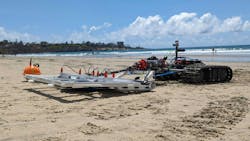Marines seek to solve the puzzle of mine detection in the lethal zone of where water meets the land
Summary points:
- The U.S. Marine Corps are asking Greensea Systems to develop an uncrewed autonomous tracked vehicle to detect and neutralize mines in the hazardous surf zone.
- Greensea's Bayonet AUGVs, available in three sizes, are engineered to operate in water and on land, with payload capacities ranging from 50 to 300 pounds, and battery life of as long as six hours.
- Uncrewed vehicles will protect Marines by identifying hidden mines and explosives in shallow waters, reducing the risk of casualties during amphibious landings, a challenge dating back to World War II.
THE MIL & AERO BLOG – Uncrewed vehicles consistently have proven their worth when it comes to detecting and disabling hidden mines on land and in the water. A variety of floating and submersible uncrewed land vehicles and ocean vehicles are taking the front lines in the war on mines.
While uncrewed ground vehicles (UGVs), uncrewed surface vessels (USVs), and uncrewed underwater vehicles (UUVs) are effective in their respective domains, the areas along the surf zone of beaches -- part land, and part ocean -- have been a particularly difficult problem for uncrewed vehicles, until now.
The U.S. Marine Corps has an intense focus on the surf zone and on the threats that lurk within the waves for Marine commanders who are moving infantry and their equipment from amphibious ships offshore onto the beach. The surf zone has been an unusually lethal operational area for Marines and soldiers at least for as long as the invasions of Normandy and Iwo Jima during World War II.
The surf zone that involves a mix of land and water is where attacking infantry are at their most vulnerable. They can't avoid moving slowly through the waves and wet sand, and not only must they contend with opposing forces defending the beach, but they also must deal with hidden booby traps located just out of sight in the shallow water.
Where water meets land
That's about to change, however, with a Marine Corps $10 contract awarded this past summer to Greensea Systems Inc. in Richmond, Vt., to develop the Amphibious Unmanned Ground Vehicle (AUGV), as part of the Littoral Explosive Ordnance Neutralization Family of Systems.
The Marine Corps AUGV is to be an uncrewed tracked autonomous crawler that prowls the pounding waves and shifting sands of the surf zone, hunting for hidden mines that threaten the attacking force.
The Marine Corps AUGV is to be based on the Greensea Bayonet series AUGV, which comes in three different sizes with the models 150, 250, and 350. Each size has a different payload capacity and endurance, and is designed to operate in the beach surf zone.
The Greensea Bayonet is designed for amphibious surf zone robotics operations, and are built to switch from the ocean into the surf zone and onto the beach, with capabilities for harsh marine environments and heavy payloads.
RF link buoy control
Key features of Bayonet systems include autonomous operation with the option for tethered or RF link buoy control; high stability and low profile for penetrating waves as high as six feet; long battery life of about six hours of operation between recharging.
Bayonet can operate in water at depths to 330 feet, and has a payload deck weight capacity ranging from 50 pounds on the smaller model to 300 pounds on the largest. The amphibious UGV is built for explosives ordnance disposal (EOD), mine detection, amphibious reconnaissance, neutralization, and coastal survey.
The Bayonet series AUGVs consists of the two-person portable 150 for small payloads and light weather and surf conditions, the 250 for harsh conditions and extensive payload requirements, and the 350 for the heaviest payloads harsh conditions. It's standard range is 10 miles submerged and 24 miles dry; a 1.5-knot speed, and high sounding density.
Three sizes
The Bayonet 150 measures 44 by 36 by 10 inches, weighs 290 pounds, has a battery life of 6 hours, and has a deck capacity of 50 pounds. The Bayonet 250 AUGV measures 48 by 48 by 15 inches, weighs 390 pounds, and has a deck capacity of 200 pounds. The Bayonet 350 measures 72 by 60 by 18 inches, weighs 600 pounds, and has a deck capacity of 300 pounds.
These AUGVs are for mine countermeasures, and are designed to detect, identify, and neutralize naval mines and other explosive hazards in surf and beach zones. They also can conduct environmental monitoring in shallow waters, as well as other missions that are otherwise dangerous or difficult for human operators.
On this contract Greensea will do the work in Richmond, Vt., and should be finished by August 2030. For more information contact Greensea Systems online at https://greenseaiq.com/products/integrated-systems/bayonet-surf-zone-robotics, or Marine Corps Systems Command at www.marcorsyscom.marines.mil.
About the Author
John Keller
Editor-in-Chief
John Keller is the Editor-in-Chief, Military & Aerospace Electronics Magazine--provides extensive coverage and analysis of enabling electronics and optoelectronic technologies in military, space and commercial aviation applications. John has been a member of the Military & Aerospace Electronics staff since 1989 and chief editor since 1995.
